Long Term Test | CUBE Stereo Hybrid 140 HPA SL 27.5
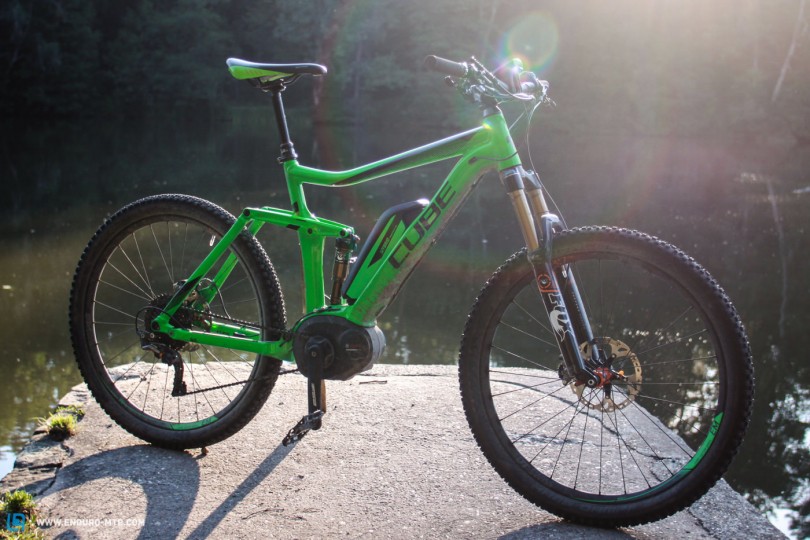
Aided by our years of road riding and mountain biking, we know exactly how to reach the limits of the bikes we are testing, how to point their weaknesses accurately and subsequently report back with our feedback to the industry. But, as e-mountain bikers won’t necessarily be rolling along the world’s gnarliest trails, we realise that’s important to assess these bikes in a slightly different way – a way that doesn’t exclusively come from the perspective of a hardcore mountain biker. Putting the CUBE Stereo Hybrid 140 HPA SL 27.5 to the long-term test is Andreas Güldenfuß, a motorbike journalist for over 25 years. After 3,000 kilometres across a wealth of terrains, here’s his verdict.
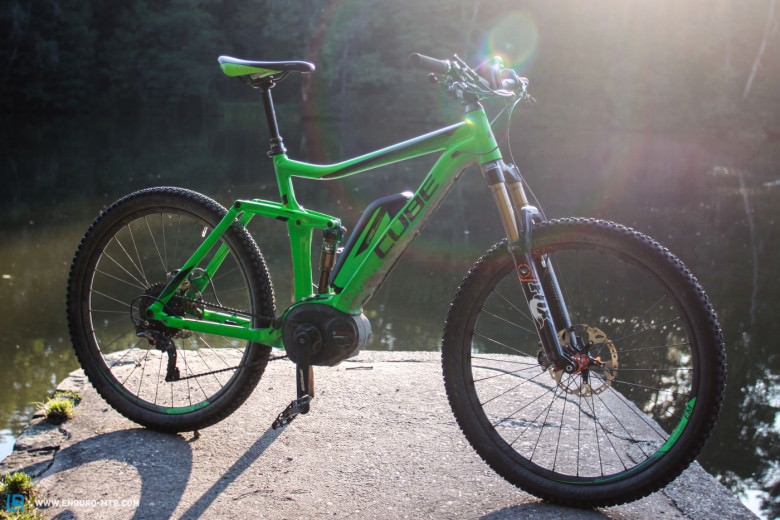
First up, the hard facts: the Stereo is one of CUBE’s most popular bikes, synonymous with forgiving full-suspension trail bikes. CUBE have christened each of their E-Bikes as ‘Hybrid’, encompassing everything from their hardtails via the WLS (Woman Like Series) to the urban city-bikes SUV. The Stereo Hybrid comes in six models, including a 29er with 120 mm travel and a 27.5er with 140 mm travel. Retailing between 2,999 € and 5,499 €, our Stereo Hybrid 140 HPA SL 27.5 has inched its way towards the upper end of the price spectrum and – as a result – the spec doesn’t leave much room for desire. Weighing in at 22 kg, the bike is satisfyingly well scaled.
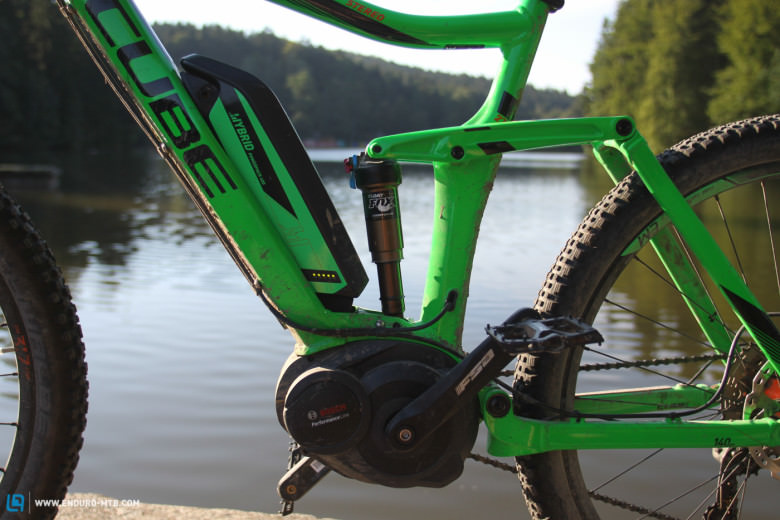
The frame
Built from lightweight alloy and created expertly using Advanced Hydroforming, riders looking for the CUBE’s Advanced Twin Mold carbon fibers will still have to wait a while. The triple butted aluminium frame, tapered head tube and robust thru-axles guarantee rigidity. Located low, the battery is partially integrated into the frame, and the subsequent wider frame build houses the motor effectively while increasing the stability around the bottom bracket. The cables primarily disappear off into the roomy frame, with just the cables for the rear disc brakes and the dropper post tidily running along the downtube.
The suspension
To fully profit from an E-MTB’s advantages, a top rate suspension set up is crucial. For the forks, CUBE went for 34er FOX FLOAT with FIT (FOX Isolated Technology), whose bladder prevents air and oil from mixing and thus ensures consistent and predictable damping performance. Also featuring the quick CTD (Climb, Trail, Descend) modes, these forks are ideal for a trail bike that wants to be simple to use and able to work on a daily basis. The Kashima coating ensures a long-life span for the surface and sensitivity in use.
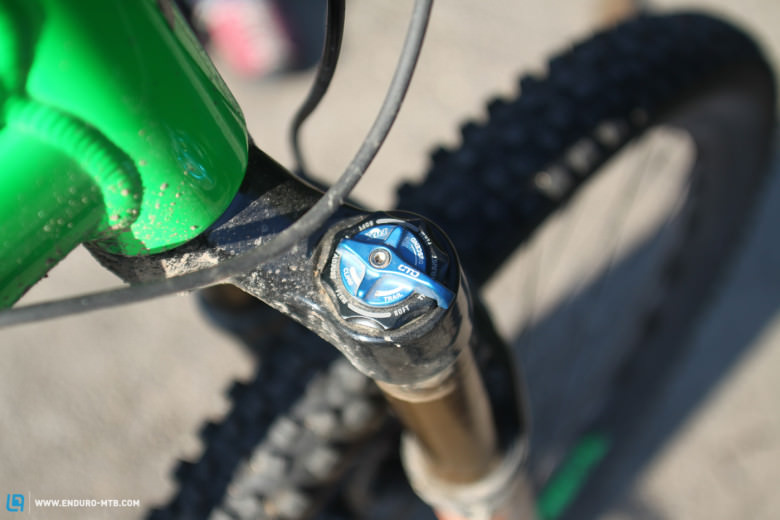
Compared to conventional bikes, E-MTBs see a whole new set of demands placed on their suspension, and shock-absorption and stability overtake efficiency on the priority list – after all, you’ve got a motor and therefore it’s not strictly necessary for every single exerted watt to be transformed into motion. However, you do still need a bike with a suitable spring line, and suspension that can cope with the heavier weight of the bike, the weight distribution and the torque that’s running through the frame and suspension from the motor.
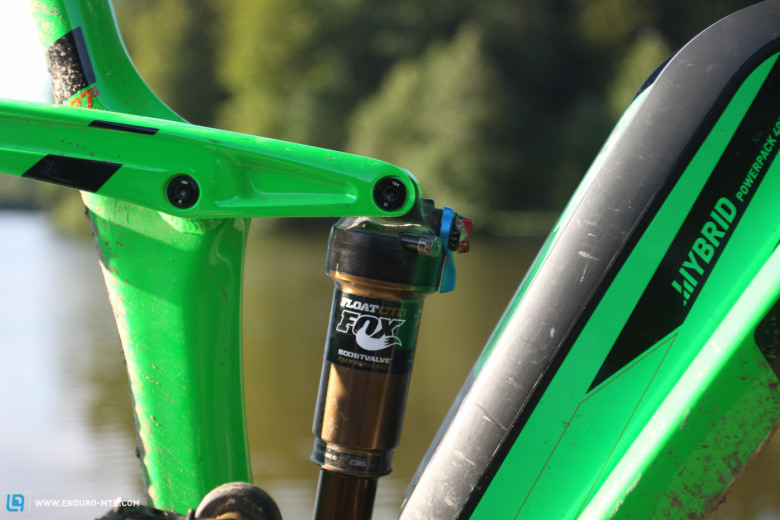
At the rear there’s a Factory air shock from FOX, also featuring the CTD mode adjustment. Setting up the modes take a bit of practice until you’ve nailed the position of which lever goes where. CUBE decided not to give the Stereo a bar-mounted lever – but considering you’ve got a little extra watt assistance anyway, the need to stretch downwards every so often should not be a deal-breaker.
The spec
No room for complaint here, as the CUBE embodies nigh on perfection. With a drive hailing from Bosch, the battery states Bosch Professional and the E-motor says Bosch Performance. The Drive Unit, i.e., the motor, is well housed on the bike, weighing just 4 kg by the bottom bracket area. Three sensors observe at a lightning rate just what is going on between the rider and the cranks, offering up to 60 Nm torque depending on which mode you’re in. The Bosch Power Pack, the 400 Wh lithium-ion battery, adds another 2.5 kg to the overall weight and is stylishly integrated into the frame. While the accompanying cockpit is on the boring side, with typical bike computers offering more information and not really coming across as a technological masterpiece, it is robust and has proven that it is able to survive minor crashes.
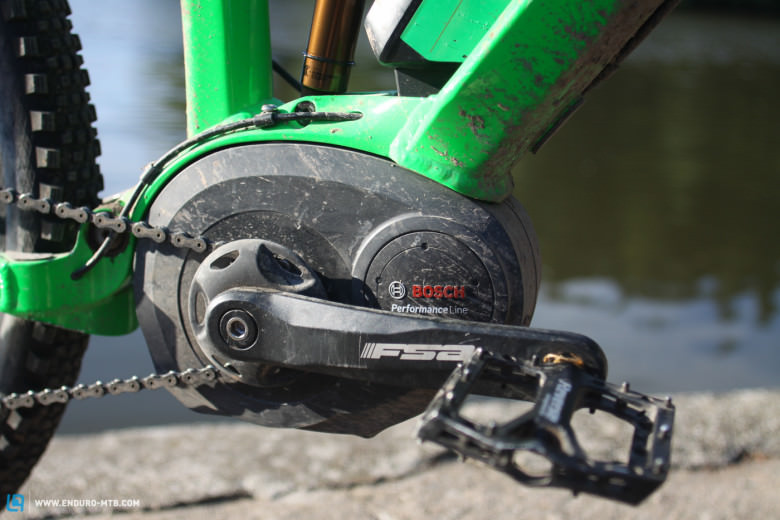
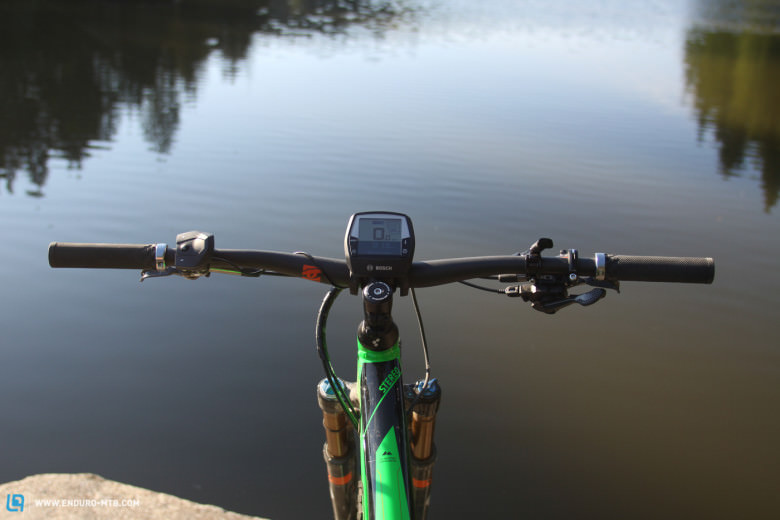
If you’re used to old school marathon and XC bikes, then you’re forgiven for initially thinking that the Race Face SixC carbon bars are a touch on the wide side at 760 mm. But both the bars and the stem, which also happens to be Race Face, prove themselves a force to be reckoned with, not once showing any sign of fatigue. Apropos fatigue: CUBE use their own lab to test the durability of all of the carbon bars which will be used in the range.
On a par when it comes to robustness, Shimano’s 11-speed XTR shifting set and their 11-40 cassette gives a commendable gear ratio for any climb – and for everything else you’ve got the Bosch controller on the left side. The brakes, which are also XTR, come courtesy of the same brand, and feature stylish, radially mounted mono-block brake calipers with 180 mm wave discs. Isolated pistons and sufficient cooling fins result in a fine and easy-to-modulate braking performance. If you’re planning on frequently taking on long descents, then 200 mm disc brakes will be a wise investment.
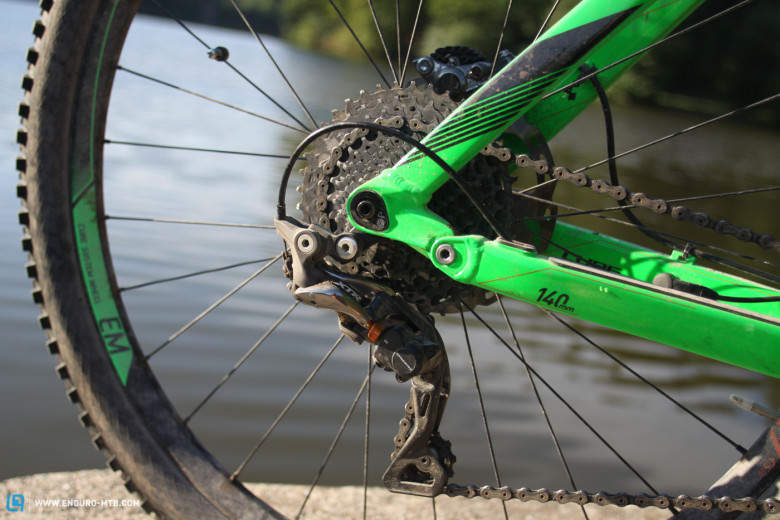
DT CSW EM 3.7 straightpull tubeless ready – behind this rather cryptic product description stand some custom wheels from DT Swiss with DT EX471 rims that measure 30 mm in diameter, DT 350 hubs and straight pull spokes. At the front, the Schwalbe Hans Dampf Kevlar will keep you on track while the rear’s Schwalbe Rock Razor does the same. Both tyres are 2.35″ wide. The height-adjustable RockShox Reverb Stealth dropper post is an absolute must for all (future) bikes, and it’s a whizz to manage from the bar-mounted control.
Naturally the bike boasts a ton of other goodies including the seat clamp and the FSA crank set, but these are parts that we don’t often have that much to do with as riders, and aren’t ones that tend to suffer wear and tear over the course of the long-term test – and I should probably reveal that the Fi`zi:k Gobi saddle was a bit put out that it didn’t get the first mention here!
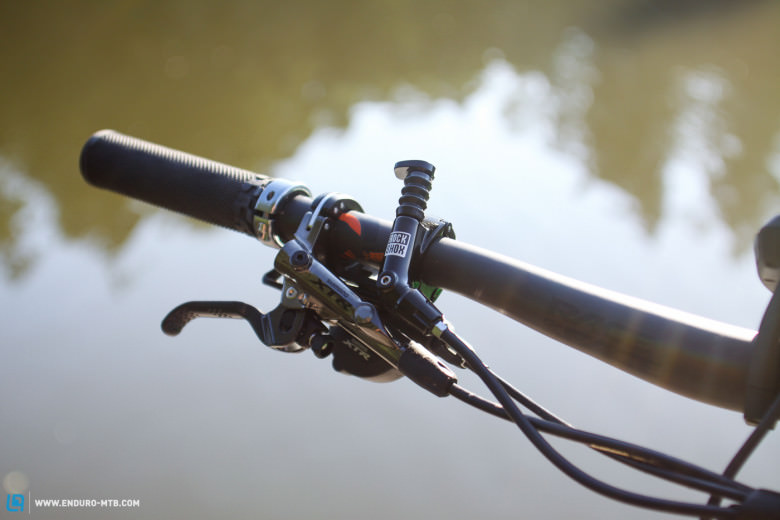
The ride
Far more important to deal with now is the pressing question of how the CUBE fared in the long-term test? Or rather: how is the CUBE actually being ridden in the long-term test? It’s an easy answer, as it’s ridden constantly. It’s ridden every day, despite the rider being older than 40 years old, having undergone several surgeries on the knee, artificial cartilage and no meniscus – pretty much what you’d expect after 20 years of motorcycle enduro. If there’s any discomfort at the start, it’s just a case of turning up the level of pedal assist one notch and after a good 10 minutes, the joints are oiled and turning as you’d hope. Does that mean it’s just a bike for OAPs and invalids? Probably not, although the colour did strike me as being well suited for a certain German health insurance company to distribute to their members. And that’s an expense that would pay off quickly, as studies show that health insurance companies will spend around 25 billion euros by 2020 when it comes to treating diseases that are linked to a lack of exercise.
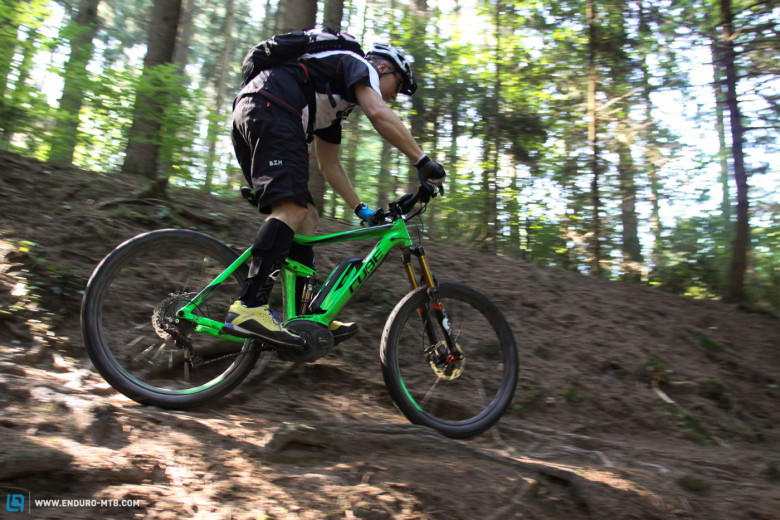
An E-MTB allows you to overcome your inner lack of will power; after all, some movement is better than no movement. But even if your aspirations are higher, an e-bike is a brilliant accouterment. You cross more ground than on a regular bike, and really push yourself to the limit. In short: the eco mode helps you to grind your way up a hometrail climb at 20 km/h until you’re seeing stars, then you sit back down, switching up into Tour or Sport mode to regain a less worryingly aggressive heart rate – and there’s your rest. It’s just like a spinning class, expect you don’t have your car parked outside the gym – you’re relying on uncle Bosch to get you home instead. E-MTBs can seriously awaken and enrich your drive for adventure too, and there’s no reason not to take an unknown trail – even if you end up with the hunger knock, there’s also the push help, but that’s pretty unlikely.
Admittedly perhaps I’m not doing it quite right, as I frequently switch the motor off. On gradients when the bike voluntarily moves, the motor is kept off. Only once I start to feel the resistance from the motor, do I switch into Eco mode; the Bosch has notable palpable friction inside. Although even then, there’s often too much support for me. I’d prefer a mid-mode which would just counteract the resistance from the motor so that the bike would ride like a normal, if not slightly obese, fully.
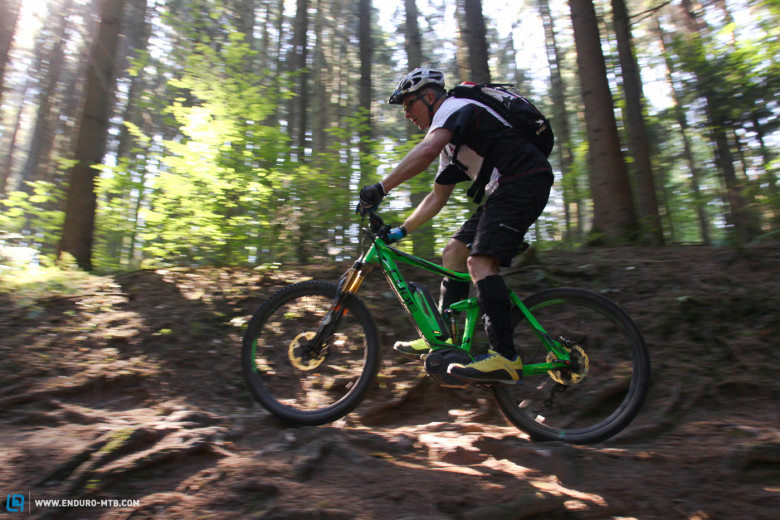
Riding the CUBE is the definition of a good time. Even though the wide bars that kept catching on every tree I passed rendered it slightly odd to begin with, I have more than got used to the incredibly cool riding position, and enjoy how the suspension and the tyres just steam the terrain flat. Roots, branches, rocks, ditches – under the bike they’re all the same and don’t require a second thought. However, the comfort-enhancing low 1.5 bar air pressure does have its drawbacks, such as when you’re trying to pick up speed or land anything other than perfectly straight.
Of course, the CUBE has been travelling a bit, with Lake Garda an obvious destination and Arco its good friend, although Galtür and the Paznaun Valley are its real home trails. Even after a mountainous 80km with around 2,500 metres of climbing, the battery still won’t run dry – providing you’re stingy enough with it in the first place.
It’s possible that I’m too frugal riding the Stereo, as I still haven’t managed to drain the battery. Completely unintentionally, I just don’t seem to have the time to spend on epic long rides. When I do get out for a ride, I want to feel like I’m training, using the pedal assist only when necessary or when it will work to prolong the fun of riding.
On another note, I’m perhaps neglectful when it comes to keeping the bike serviced. Besides oiling the chain, controlling the air pressure in the shock and cleaning the bike after rides, I haven’t actually done anything else. But that’s another factor that’s important to consider: what are the running and maintenance costs for any buyer? After 3,000 km, the chain is knackered and it’s time that the forks and shock got serviced. The tyres, on the other hands, are astonishingly still going strong. Despite the low 1.5 bar pressure, the wear and tear is minimal – largely due to the absence of riding on the tarmac. After my next mountain ride I’ll check the brake pads once more.
Accessories and technical changes have been deliberately avoided, after all, we’re curious about how the original stock parts perform. The stock motor, coming without a specific protective plate, has become dislodged countless times, be it from stone steps or tree stumps, although still doesn’t show a single dent in its plastic casing. The bearings on the pedals have taken some hits too, but are still going strong without any sign of noise or play.

But there’s still one major question to deal with: just how much life is there in what is essentially fairly new technology? How many times can the battery be charged before the capacity is reduced? What happens when parts in the motor get tired? So far, we haven’t had to deal with anything serious, but these issues may well rear their head during the long-term test. This is only half time, guys.
The conclusion thus far
Sometimes I find myself longing for my hardtail and cyclocross bike – although I have to admit that I’ve rarely been out riding so much and as often as I have with the Stereo. No matter how shattered you are, it’s just a case of getting on and setting off. The rest takes care of itself. The technology amazes me; the battery has now been charged 35 times, and it’ll reasonably deal with at least 1,000 charges before its capacity noticeably dwindles. Whether the motor and the rest of the bike can last that long too remains to be seen. It’s certainly exciting, as replacement parts are significantly more expensive than those for a regular bike. This long-term test won’t ride the Stereo down to the ground, but after 4,000 – 5,000 km, it’ll be enough for a definitive conclusion
Would I rush out and buy a CUBE Stereo Hybrid 140 HPA SL 27.5? Absolutely. I’ve already had to buy my wife the CUBE Reaction Hybrid HPA Race 27.5 so I’ll need to keep up once this test is over.
About the writer:
Andreas Güldenfuß, 43 years old. Editor for 25 years in the motorcycle industry, who grew up with enduro – albeit plus a motor and at a national level in Germany. Over the past year he’s developed a special attachment to e-mobility and distance remaining: as the Country Manager at Zero Motorcycles for Germany, Austria and Switzerland, he’s often on the road and never heads away without his test bike in the back of his van for Alpine business trips.
Text & Photo: Andreas Güldenfuß
Did you enjoy this article? If so, we would be stoked if you decide to support us with a monthly contribution. By becoming a supporter of E-MOUNTAINBIKE, you will help secure a sustainable future for high-quality cycling journalism. Click here to learn more.








